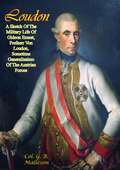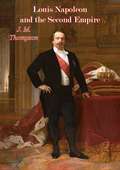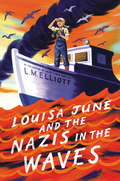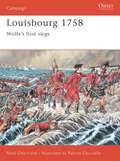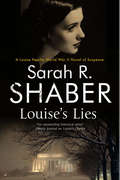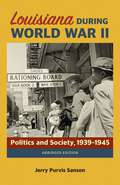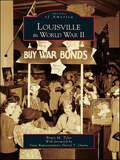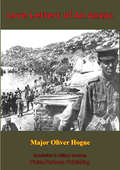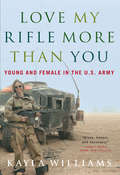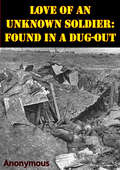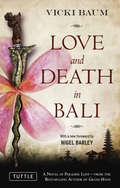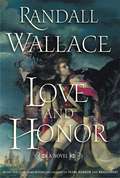- Table View
- List View
Loudon: Sometime Generalissimo Of The Austrian Forces
by Col. G. B. MallesonFew Generals left such a shining legacy of military genius and glory than Frederick the Great and his Prussian army, however, this reputation was hard fought and grimly won against the forces of Austria. The leading Austrian general, who frustrated many of Frederick's designs, was General Frieherr von Loudon, a soldier through and through. In this detailed biography, noted military author Colonel Malleson traces Loudon's rise from obscurity to the forefront of the Austrian military effort of the Seven Years War. One of the few generals to have bested the Prussians; he won brilliant victories at Hochkirch, Kunersdorf, Landshut, Glatz and Schweidnitz. Frederick himself when talking over the events of the war, then a thing of the past, with his generals, he exclaimed: "We all of us made mistakes, except my brother Henry and Loudon."
Louis Napoleon and the Second Empire
by J. M. ThompsonAn excellent one volume portrait of Napoleon III and the short-lived second French Empire which was brought to ruins by the 1870 Franco-Prussian war.“ONCE again J. M. Thompson has given us a colorful, arresting, and interpretative account of a period of French history—this time of the Second Empire. In this instance, as in previous works, the author makes the biography of a man (Louis Napoleon) the vehicle for a history of a period, thereby infusing the warmth of a very human personality throughout the history of a complex and fateful era. Thus we follow the life of a man who followed his star of fate from youthful refugee to insurrectionist, prisoner, president, emperor, economic reformer, arbiter of a continent, prisoner-of-war, and, alas, to refugee again until death.Nothing of the romance, the contrasts, the shaded significances is lost by the author's telling. Those who have read his French Revolution and Napoleon Bonaparte cannot fail to discern and appreciate the same trenchant pen and deft brush which restore life and odor to a much-told tale of the past. While Mr. Thompson does not attempt to conceal the faults and mistakes of the man, in the main he joins with some current revisionists in understanding (not justifying) the "crime of December 2nd" and crediting Napoleon Ili with constructive policies at home and abroad and exonerating him of the major responsibility for the outbreak of the war of 1870. The author rightly blames Bismarck and French public opinion of all classes for pushing Louis Napoleon into the war (p. 272) rather than just a small war party and the empress.”-Lynn M. Case
Louisa June and the Nazis in the Waves
by L. M. ElliottIn this moving and timeless story, award-winning author L. M. Elliott captures life on the U.S. homefront during World War II, weaving a rich portrait of a family reeling from loss and the chilling yet hopeful voyage of fighting for what matters, perfect for fans of The War That Saved My Life. Days after Japan’s attack on Pearl Harbor in 1941, Hitler declared war on the U.S., unleashing U-boat submarines to attack American ships. Suddenly, the waves outside Louisa June’s farm aren’t for eel-fishing or marveling at wild swans or learning to skull her family’s boat—they’re dangerous, swarming with hidden enemies.Her oldest brothers’ ships risk coming face-to-face with U-boats. Her sister leaves home to weld Liberty Boat hulls. And then her daddy, a tugboat captain, and her dearest brother, Butler, are caught in the crossfire. Her mama has always swum in a sea of melancholy, but now she really needs Louisa June to find moments of beauty or inspiration to buoy her. Like sunshine-yellow daffodils, good books, or news accounts of daring rescues of torpedoed passengers.Determined to help her Mama and aching to combat Nazis herself, Louisa June turns to her quirky friend Emmett and the indomitable Cousin Belle, who has her own war stories—and a herd of cats—to share. In the end, after a perilous sail, Louisa June learns the greatest lifeline is love.
Louisbourg 1758
by Rene Chartrand Patrice CourcelleOsprey's study of James Wolfe's siege of Louisbourg during the French and Indian War (1754-1763). Louisbourg represented a major threat to Anglo-American plans to invade Canada. Bypassing it would leave an immensely powerful enemy base astride the Anglo-American lines of communication - Louisbourg had to be taken. Faced with strong beach defences and rough weather, it took six days to land the troops, and it was only due to a stroke of daring on the part of a young brigadier named James Wolfe, who managed to turn the French beach position, that this was achieved. The story is largely based on firsthand accounts from the journals of several participants, including French Governor Drucour's, whose excellent account has never been published.
Louise's Lies: A 1940s Spy Thriller Set In Wartime Washington D. C. (The Louise Pearlie World War II Novels of Suspense #6)
by Sarah R. Shaber&“Shaber&’s winning sixth WWII mystery is her best yet&”—from the award-winning author of Louise&’s Chance and Louise&’s Crossing (Publishers Weekly, starred review). When a body is discovered in a Washington bar, government girl Louise Pearlie is forced into a role of lies and deception. On a bitterly cold night in December 1943, Louise Pearlie and her friend Joe Prager are enjoying a quiet drink in the Baron Steuben Inn when a bloodstained body is discovered behind the bar. Although the victim had been a regular customer, no one seems to know anything about him. When it turns out there is a link to Louise&’s top-secret work at the OSS, she is ordered to find out as much as possible about the murder while keeping the connection secret from those involved, including the investigating police detective. Although Louise has been trained to keep secrets, the constant deception is taking its toll—especially when she discovers that she&’s not the only customer at the Steuben that night with something to hide. Will Louise&’s silence result in an innocent man being arrested for murder? &“[Louise&’s] sixth adventure is a worthy addition to the franchise.&”—Kirkus Reviews &“Shaber does a fine job portraying the plight of alien residents in wartime Washington, besides conveying the hectic atmosphere of a city whose resources are stretched to the limit by an influx of new workers.&”—Publishers Weekly (starred review)
Louisiana during World War II: Politics and Society, 1939–1945
by Jerry Purvis SansonWhile the impact of World War II on America and other countries has been exhaustively chronicled, few historians have investigated the experiences of individual states during the tumultuous war years. In his study of Louisiana’s home front from 1939 to 1945, Jerry Purvis Sanson examines changes in politics, education, agriculture, industry, and society that forever altered the Pelican State. The war era was a particularly important time in Louisiana’s colorful political history. The gubernatorial victories of prominent anti–Huey Long candidates Sam Jones in 1940 and Jimmie Davis in 1944 reflected shifting sentiments toward politicians and heralded a changing of the guard in the statehouse. This created a system of active dual-faction politics that continued for the next decade. The war also transformed the state’s economy: agricultural mechanization accelerated to compensate for labor shortages, and industries increased production to meet military demands. Louisiana’s educational system modified its curriculum in response to the war, providing technical training and sponsoring scrap-metal collections and war-stamp sales drives. Sanson explores the war’s effect on the everyday lives of Louisianians, showing how their actions at home provided them with a sense of personal participation in the titanic effort against the Axis powers. He also points out that, while many found their lives limited by war, two groups—African Americans and women— experienced increased opportunities as they moved from low-paying jobs to more lucrative positions vacated by white males who had departed for the service. Now condensed for easy and efficient access, Sanson’s historical account provides a wide-ranging yet intimate look at how the war was brought home to the people of the Bayou State.
Louisville in World War II (Images of America)
by Bruce M. TylerWith the bombing of Pearl Harbor in December 1941, Louisville mobilized to fight Nazi Germany and Imperial Japan. Citizens of all races and economic classes united in the effort, both abroad and at home. Louisville�s many industries banded together as well: the Mengel Company made wood products used in the war, and its staff burned a Nazi flag in an employee-held rally; Reynolds Aluminum Company manufactured arms and other war materials; Liberty National Bank sold war bonds at special windows; and the Louisville Ford Motor Company made at least 93,389 military jeeps out of the roughly 500,000 employed in the war. Perhaps Louisville�s most significant war contribution, though, was the use of Bowman Field as a United States Army Air Corps Detachment Squadron. The pilots trained there were vital to the war effort.
Love & War in Afghanistan
by Alex Klaits Gulchin Gulmamadova-KlaitsLove and War in Afghanistan presents true stories of fourteen ordinary men and women living in Northern Afghanistan. In a quarter-century of uninterrupted war, the people of Afghanistan have endured foreign invasions, ethnic strife, a fundamentalist Islamic totalitarian regime, and the unending crossfire of rival warlord factions. The country remains an object of fascination for journalists, academics, and filmmakers from around the world. In the midst of it all it is a startlingly powerful experience to discover, here, the voices of the Afghan people themselves. Young lovers who elope against the wishes of their kin; a mullah whose wit is his only defense against his armed captors; a defector from the Soviet army; a woman who is forced to stand up to gangsters in Tajikistan--their dramatic stories emerge in their own unforgettable words. Whether in the sudden awakening of mercy in a Taliban militiaman, the lingering contempt of a woman for her husband's first wife, the pain and confusion of flight into exile, or the resourcefulness of a child who must provide for an entire family, the real focus of these narratives is the strength of solitary individuals faced daily with their own vulnerability. Men, women, orphans, widows, widowers, Tajiks, Pashtuns, Uzbeks, Turkmens, schoolteachers, mullahs, former Taliban, mujahideen, big brothers, little sisters, captive wives, lovers in flight: Love and War in Afghanistan tells their stories, putting human faces onto a country torn by war.
Love For An Enemy
by Alexander FullertonIn wartime Egypt, can a British submarine commander trust his Italian lover?1941: The teeming city of Alexandria is almost under siege by the Afrika Korps. A vortex of ancient loves and murderous intrigues, Alexandria is the Royal Navy’s major Eastern Mediterranean base. But Italian frogmen and their so-called ‘human torpedoes’ are posing a lethal threat to British warships.Hardly the time or place for a British submarine commander to fall in love, especially as the girl in question is half-Italian, and Alexandria’s large Italian population is only too eager to welcome Rommel and his troops into town. Interspersed with scenes of naval action described in gripping and authentic detail – seen through Italian as much as British eyes – the human drama unfolds, its actors ever aware of the mounting threat of a German breakthrough. A stunning naval thriller sure to enthral readers of Philip McCutchan and Jeff Edwards, Love For An Enemy shows Alexander Fullerton at the peak of his form.Praise for Alexander Fullerton‘The most meticulously researched war novels that I have ever read’ Len Deighton ‘The scene of battle is quite overpowering’ Sunday Times‘His action passages are superb, and he never puts a period foot wrong’ Observer
Love Letters From An Anzac [Illustrated Edition]
by Major Oliver Hogue"Oliver Hogue (1880-1919), journalist and soldier, was born on 29 April 1880 in Sydney ...He enlisted in the Australian Imperial Force in Sep. 1914 as a trooper with the 6th Light Horse Regiment. Commissioned second lieutenant in Nov., he sailed for Egypt with the 2nd L.H. Brigade in the Suevic in Dec..Hogue served on Gallipoli with the Light Horse (dismounted) for five months, then was invalided to England with enteric fever. In May 1915 he was promoted lieutenant and appointed orderly officer to Colonel Ryrie, the brigade commander. As 'Trooper Bluegum' he wrote articles for the Herald subsequently collected in the books Love Letters of an Anzac and Trooper Bluegum at the Dardanelles. Sometimes representing war as almost a sport, he took pride in seeing 'the way our young Australians played the game of war'.Hogue returned from hospital in England to the 6th L.H. in Sinai and fought in the decisive battle of Romani. Transferred to the Imperial Camel Corps on 1 Nov. 1916, he was promoted captain on 3 July 1917. He fought with the Camel Corps at Magdhaba, Rafa, Gaza, Tel el Khuweilfe, Musallabeh, and was with them in the first trans-Jordan raid to Amman. In 1917 Hogue led the 'Pilgrim's Patrol' of fifty Cameliers and two machine-guns into the Sinai desert to Jebel Mousa, to collect Turkish rifles from the thousands of Bedouins in the desert.After the summer of 1918, spent in the Jordan Valley, camels were no longer required. The Cameliers were given horses and swords and converted into cavalry. Hogue, promoted major on 1 July 1918, was now in Brigadier General George Macarthur-Onslow's 5th L.H. Brigade, commanding a squadron of the 14th L.H. Regiment. At the taking of Damascus by the Desert Mounted Corps in Sep. 1918, the 5th Brigade stopped the Turkish Army escaping through the Barada Gorge. As well as the articles sent to Australia, and some in English magazines, Hogue wrote a third book, The Cameliers,..."-Aust. Dict. of Nat. Bio.
Love Like Hate: A Novel
by Linh DinhLinh Dinh is already one of the secret masters of short fiction. Love Like Hate is something like a traditional cross-cultural novel that's been shocked into life by Dinh's uncanny ability to tell us stories we didn't even know we wanted to hear. -- Ed Park, editor of The BelieverIn Love Like Hate, Linh Dinh weaves a dysfunctional family saga that doubles as a portrait of Vietnam in the last half century. Protagonists Kim Lan and Hoang Long marry in Saigon during the Vietnam War, uniting in a setting that allows Dinh's dark, deadpan humor to flourish. Describing his mushrooming cast of characters in unsentimental and sometimes absurd ways, Dinh embraces contradictions with the surreal exuberance of Matthew Sharpe and the stylistic élan of Italo Calvino.
Love My Rifle More Than You: Young and Female in the U.S. Army
by Michael E. Staub Kayla Williams"A woman soldier has to toughen herself up," writes Kayla Williams in this fiercely honest account of what it's like to be part of the female 15 percent of today's Army. "Not just for the enemy, for battle, for death. I mean to toughen herself to spend months awash in a sea of nervy, hyped-up guys " Irreverent, vulnerable, angry, and humane, Williams describes what it's like for a young woman to be surrounded by an ocean of testosterone, respected for her skills and qualifications but treated variously as a soldier, a sister, a mother, a bitch, and a slut. During her five years of service -- including a year of deployment to Iraq during and after the invasionWilliams and her female peers navigate both extreme physical danger and emotional minefields. As a specialist in Military Intelligence, fluent in Arabic language skills, Williams finds herself at the forefront of the troops' interaction with local people. Brave and patriotic, with a strong sense of duty to her country and her fellow soldiers, +
Love My Rifle More than You: Young and Female in the U.S. Army
by Michael E. Staub Kayla Williams"Brave, honest, and necessary."--Nancy Pearl, NPR Seattle Kayla Williams is one of the 15 percent of the U.S. Army that is female, and she is a great storyteller. With a voice that is "funny, frank and full of gritty details" (New York Daily News), she tells of enlisting under Clinton; of learning Arabic; of the sense of duty that fractured her relationships; of being surrounded by bravery and bigotry, sexism and fear; of seeing 9/11 on Al-Jazeera; and of knowing she would be going to war. With a passion that makes her memoir "nearly impossible to put down" (Buffalo News) Williams shares the powerful gamut of her experiences in Iraq, from caring for a wounded civilian to aiming a rifle at a child. Angry at the bureaucracy and the conflicting messages of today's military, Williams offers us "a raw, unadulterated look at war" (San Antonio Express News) and at the U.S. Army. And she gives us a woman's story of empowerment and self-discovery.
Love Of An Unknown Soldier: Found In A Dug-Out [Illustrated Edition]
by AnonymousIncludes the First World War Illustrations Pack - 73 battle plans and diagrams and 198 photos'I think of you, as I shall think of you to the end, if the end comes. I do not want you less. I want you more perhaps, only not so selfishly. I realize that death does not finish all things. Love lives on. There are other worlds--there must be so many other worlds--in which I shall surely meet you if I miss you in this one. That I, so poor and human and puny, should be capable of this largeness of spirit, gives me confidence that God's scheme for us must be greater than we have guessed. He cannot be smaller than the souls He has created. You may not need me in this existence. We may have met too late to be much to each other. But I cannot think love is wasted.'The Love of an Unknown Soldier collects the intimate letters written by an anonymous World War I officer in Paris to his American love. Found by a young British soldier at the end of the war, the documents had been wedged in the wall of an abandoned gun dug-out, secreted away, and never mailed by the original author. There was no indication of the name or unit of the writer, presumed dead, nor did he mention the name of the girl he loved so dearly. Since tracing the letters' owner proved impossible, the young officer sent them to the publisher John Lane in an attempt to bring the letters to the attention of the American woman for whom the letters were written. The lady was never found, however, and the romantic soldier remains a mystery today.First published in 1916, this touching correspondence provides a clear depiction of the emotional realities and devastation of war.'- Print ed.
Love Runs Deep (Changing Tides #1)
by Gail ChianeseActive duty is no time for romance, but when two naval officers find themselves in truly close quarters on the USS California, the temptation to fraternize is hard to resist. Can two ambitious sailors follow orders long enough to see if love is on the horizon when they’re finally above water? Lieutenant Nic Riley is the only girl in a long-time Navy family, and she’s determined to prove she’s just as seaworthy as her brothers. When she aces training for submarine duty, it calls for a celebration—and one incredibly hot guy is happy to party with her all night long. But when Nic boards the sub and finds herself face to face with her hunky fling, the idea of spending six months underwater takes on a whole new meaning . . . Having a girl in every port was Lieutenant Kyle Hutchinson’s style—until the explosive night he spent with Nic. Dating onboard is firmly off limits, but Kyle can’t get her off his mind much less out of his vicinity—until a junior seaman’s devastating stunt puts Nic’s career in danger. Kyle won’t let her take the heat alone, even when it means risking his own reputation, but fighting for a future together will be a whole new battle . . .
Love Thy Neighbor: A Story of War
by Peter MaassAn American reporter recounts his experiences in Bosnia.
Love You More Than You Know: Mothers' Stories About Sending Their Sons And Daughters To War
by Janie Reinart Mary Anne MayerIn these stories, mothers share their feels about sending sons and daughters off to war.
Love and Death in Bali
by Nigel Barley Vicki BaumSet against the backdrop of the Dutch invasion of Bali just over a century ago, and the resulting "mass suicides" of the Balinese royalty, Love and Death in Bali uses the tales of ordinary people to tell the bloody story of the conquest and subjugation of an island paradise.
Love and Death in Bali
by Nigel Barley Vicki BaumSet against the backdrop of the Dutch invasion of Bali just over a century ago, and the resulting "mass suicides" of the Balinese royalty, the moving story unfolds of the peasant Pak and his family and friends, and the tragedy that is their shared fate.Written within living memory of the bloody events called the puputan (the "ending"), Love and Death in Bali is the story of a passionate yet peaceful and deeply spiritual people who defy the Dutch imperial forces through an act that would bring them certain death--and certain rebirth.The looting of a Chinese trading ship gives the Dutch colonial forces the perfect excuse to intervene in island affairs, but they encounter astonishing resistance. In the battle of Badung, wave upon wave of Balinese clothed in white ceremonial garb charged into the blazing Dutch guns, kris daggers in hand, prepared to die. Who among them will survive, and how will their lives be forever changed?Love and Death in Bali, first published in German in 1937, is considered by many to be the finest novel ever written about this island paradise where everyone, regardless of caste of position, is woven into the fabric of an ancient culture.
Love and Glory
by Jeane Eddy WestinTHROUGH THE FIRE AND FURY OF WORLD WAR II, THEY RISKED THEIR HEARTS AND THEIR LIVES ... On a hot July day in 1942, at a military base in Iowa, their friendship began: wisecracking, softhearted Bunny; Page, the ambitious Army brat; naive, tormented Jill: elegant, sensual Elisabeth. Trading silk for khakis, they joined the U.S. Army as the first women officers-the WACs. From bomb-blasted England to Nazi France, from Italy to the Pacific, they plunged into the terror and splendor of war ... discovering the pride of command," the tragedy of sudden death, the passionate, deep loves that held a tender hope for tomorrow. Filled with all the ardor and gallantry of World War II. LOVE AND GLORY is the once-in-a-lifetime story of four American women who chose to serve their country-and change their destinies forever.
Love and Honor
by Randall WallaceFrom the New York Times bestselling author of Pearl Harbor and Oscar-nominated writer of Braveheart comes an epic historical page-turner: the gripping, unforgettable story of a patriot's secret mission in Russia to save America from certain defeat on the eve of the Revolutionary War. A brilliant soldier and passionate patriot, Virginia cavalryman Kieran Selkirk is summoned to a clandestine meeting in the winter of 1774. There he finds none other than Benjamin Franklin, who reveals that the British have asked Catherine the Great, the ruthless and mysterious ruler of Russia, to provide twenty thousand of her soldiers to help stamp out the revolution brewing in America. Such a force, fresh from brutal warfare with the Turks, would crush all hope of American independence. Selkirk's assignment is straightforward -- and astounding. He is to travel to Russia disguised as a British mercenary, offer his services to the Tsarina in putting down a Cossack rebellion that threatens her throne, and convince her not to join the British in their war with America. To succeed, he must cross savage terrain, battle starving wolves, avoid secret assassins, fight marauding Cossacks, and contend with a court of seductive young women. In a narrative full of passion and peril, of battles on horseback and wars within the human soul, Selkirk's mission meets with thrilling surprises, including a romantic face-off with the legendary Catherine herself. Told with the hand of a master storyteller, Love and Honor is perhaps Wallace's most ambitious project yet, taking readers back to the eighteenth century in a patriotic novel brimming with romance and heroism on the grandest scale. Exotically transporting yet deeply American, Love and Honor captures the fight for good over evil, integrity and compassion over cruelty, and true love over all.
Love and Loss at the Beach Hotel: A moving, uplifting WW1 saga (Beach Hotel Series)
by Francesca CapaldiCan true love win the day? Hetty Affleck is working as a maid at the prestigious Beach Hotel in Littlehampton. Her beau, Lorcan, is away at war and has recently stopped replying to her letters but she is determined to keep her spirits up. When she meets wealthy shipbuilder’s son Victor Perryman, they pass the time of day and they both feel a connection but she can’t allow herself to think anything more of it - not only does she have Lorcan to think of, but she and Victor are divided by wealth and class. Yet they meet again and Hetty is charmed and intrigued by Victor and his openness towards her. It becomes harder to ignore the attachment growing between them. When Lorcan comes back on leave, Hetty is forced to face her true feelings. Who does she really love, and can that love conquer everything in its path? An uplifting, emotional WW1 saga perfect for fans of Ginny Bell and Jean Fullerton Readers adore the Beach Hotel series: ‘Oh wow this story was…amazing and heartfelt…I hope there will be more in this series’***** Reader Review ‘Had me turning the pages well into the night… A five-star, well-written beach caper. A page turner from beginning to end.’***** Reader Review ‘I have enjoyed all three books in this series but this one was the best! I think that is because it is Helen’s story and Helen is the very heart of the hotel…I really enjoyed it.’***** Reader Review ‘The strong thread that runs through this series is friendship, that’s exactly what Helen Bygrove needs when things get difficult! I know it was third in series but I’m sure there’s room for a follow up! I live in hope.’***** Reader Review ‘Another brilliant book by this brilliant author’ Reader Review ‘Brilliant storyline, brilliant book. Couldn’t put it down. Family saga at its best’***** Reader Review ‘I loved this enchanting read…could not put it down…’***** Reader Review ‘Well, what a start to a new series! There are many secrets to be uncovered…I loved this book.’***** Reader Review ‘Charming…this book felt like an escape…The story was heartwarming’***** Reader Review ‘I thoroughly enjoyed this book…I’m glad there is more to come from the Beach Hotel.’***** Reader Review
Love and Payne (THIRDS #13)
by Charlie CochetA THIRDS Universe Novel Austen Payne, THIRDS Squadron Specialist Agent (SSA) for Destructive Delta and TIN operative, has seen the worst the world has to offer, faced lethal killers, and helped bring down dangerous organizations. But nothing terrifies him more than falling in love. After years of undercover work, Austen is a master at defending himself and protecting his heart… until he meets Osmond Zachary. THIRDS Defense Agent Osmond Zachary has a huge, doting family, yet something is missing in his life. After meeting grumpy, foul-mouthed, jittery cheetah Therian Austen Payne, Zach knows exactly what that something—or someone—is. Unfortunately Austen seems determined to avoid Zach at all costs. When Zach foils an assassination attempt, he ends up in the killer’s crosshairs, and Austen is Zach’s best chance at staying alive. Zach hopes the crisis will bring them closer, but Austen has every intention of walking away as soon as the danger is over. Happily ever after isn’t for guys like Austen, but Zach is determined to show him it can be….
Love and Ruin
by Paula McLainIn 1937, courageous and independent Martha Gellhorn travels to Madrid to report on the atrocities of the Spanish Civil War, and finds herself drawn to the stories of ordinary people caught in devastating conflict. She also finds herself unexpectedly - and uncontrollably - falling in love with Ernest Hemingway, a man already on his way to being a legend. In the shadow of the impending Second World War, and set against the tumultuous backdrops of Madrid, Finland, China, and especially Cuba, where Martha and Hemingway made their home, their relationship and professional careers ignite. But when Hemingway publishes the biggest literary success of his career, they are no longer equals, and Martha must make a choice: surrender to the suffocating demands of a domestic lifestyle, or risk losing her husband by forging her way as her own woman and writer. It is a dilemma that will force her to break his heart, and her own.Based on a true storyMartha Gellhorn was one of the greatest war correspondents of the 20th centuryFOR WHOM THE BELLS TOLLS was dedicated to Martha, and inspired by the time they were together in Spain. It was Hemingway's most successful book to date, it sold half a million copies within months, was nominated for a Pulitzer Prize, and triumphantly reestablished his literary reputation
Love and Ruin
by Paula McLainIn 1937, courageous and independent Martha Gellhorn travels to Madrid to report on the atrocities of the Spanish Civil War, and finds herself drawn to the stories of ordinary people caught in devastating conflict. She also finds herself unexpectedly - and uncontrollably - falling in love with Ernest Hemingway, a man already on his way to being a legend. In the shadow of the impending Second World War, and set against the tumultuous backdrops of Madrid, Finland, China, and especially Cuba, where Martha and Hemingway made their home, their relationship and professional careers ignite. But when Hemingway publishes the biggest literary success of his career, they are no longer equals, and Martha must make a choice: surrender to the suffocating demands of a domestic lifestyle, or risk losing her husband by forging her way as her own woman and writer. It is a dilemma that will force her to break his heart, and her own.Based on a true storyMartha Gellhorn was one of the greatest war correspondents of the 20th centuryFOR WHOM THE BELLS TOLLS was dedicated to Martha, and inspired by the time they were together in Spain. It was Hemingway's most successful book to date, it sold half a million copies within months, was nominated for a Pulitzer Prize, and triumphantly reestablished his literary reputation
